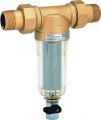Purpose
In this case is implied the temperature of the water for which the filter is designed. This parameter is directly related to the maximum operating temperature (see below). In general, modern filters fall into two main categories:
—
For cold water. Exactly this purpose that most models today have, regardless of type. This is due to two points: firstly, cold water has to be filtered more often than hot water, and secondly, filter elements for such a temperature are simpler and cheaper. The temperature limit of cold water is usually held at around 40 °C.
—
For hot water. Filters designed for connection to hot water systems.
When choosing a filter for its intended purpose, note that the use of “cold” filters with hot water should never be allowed. On the one hand, hot water usually has more impurities than cold water, which reduces cartridge life and cleaning efficiency. On the other hand, high temperature itself is an abnormal mode for filter materials, and instead of water purification, the opposite effect may even occur — the release of harmful substances from the cartridge. Therefore, for such cases, only filters designed for the corresponding temperatures should be selected.
On the other hand, the use of "hot" filters with cold water is quite acceptable — most of these models provide this possibility in case the hot water supply is turned off. However, for cons
...tant work with cold water, it does not make sense to purchase such a filter, if only because it will cost more than the “usual” one.Filtration speed
The amount of water that the filter is able to pass through itself per unit of time (of course, effectively purified in the process); usually stated in liters per minute. This parameter is largely related to the type (see above): for example, in jugs, the filtration rate usually does not exceed 0.5 L per minute, while for main devices that supply entire apartments, a throughput of tens or even hundreds of liters is required.
Note that it does not always make sense to pursue a high filtration rate. After all, other things being equal, finer cleaning takes more time; accordingly, the faster the filter works, the higher the chance that the quality of such cleaning will be relatively low. And devices that purify water efficiently and quickly usually have an appropriate price. Therefore, it is worth considering the purpose of the filter and, on the basis of this, determine the balance between the filtration speed and its quality when choosing. It is also worth keeping in mind the conditions of use: for example, if you need to filter low-quality tap water for drinking, it is better to sacrifice speed in favor of efficiency.
Max operating temperature
The highest inlet water temperature at which the filter is able to operate normally. Modern filters are conditionally divided into models for cold and hot water: the operating temperature in the first case does not exceed 40 °C, and in the second it can reach 95 °C. For more information on the importance of matching water temperature and filter characteristics, see "Purpose".
Pressure reducer
The presence of a pressure
reducer in the design of the filter — usually the main one, see "Type".
This function can be useful if the pressure at the inlet to the water supply is too high — for example, a pump with high power is responsible for it. The reducer allows you to reduce the pressure to the optimum level; using a filter with this function is often more convenient and profitable than buying a reducer as a separate device.

